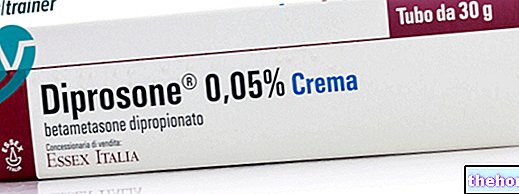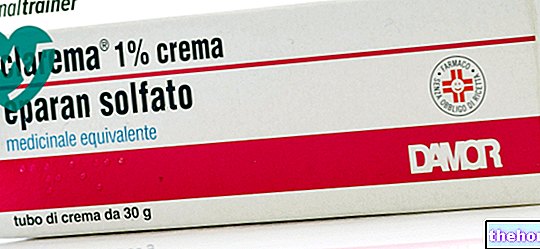Active ingredients: Tetracycline
Ambramycin 250 mg hard capsules
Why is Ambramycin used? What is it for?
Ambramycin contains the active ingredient tetracycline hydrochloride, an antibiotic that works by killing several types of bacteria that cause infections.
Ambramycin is indicated in adults and adolescents over 12 years of age for the treatment of infections caused by bacteria sensitive to tetracycline (bacteria against which tetracycline is effective), and in particular of:
- infections of the bronchi and lungs of bacterial origin (pneumonia and bronchopneumonia);
- acute and flare-up (recurring suddenly) urinary and reproductive tract infections;
- infections after surgery, for example: bone tissue infections (osteomyelitis), soft tissue infections;
- intestinal infections: infectious diarrhea (bacterial and amoebic dysentery), acute and subacute diarrheal syndromes (when the symptoms of the infection appear slowly and gradually, not suddenly);
- acute and subacute heart infections (endocarditis);
- brain infections (usually epidemic cerebrospinal meningitis and purulent meningitis);
- brucellosis (bacterial infection usually manifested by fever, sweating, malaise, weight loss, headache, muscle aches);
- rickettsiosis (infection usually presenting with fever, headache, general malaise, inflammation of small blood vessels and often associated with a rash);
- ear, nose, throat infections (tonsillitis, ear infections, sinusitis, mastoiditis);
- eye infections, for example: infections of the eyelids (blepharitis); infections of the conjunctiva, the membrane that covers the eye and the inside of the eyelid (conjunctivitis); infections of the cornea, the clear front part of the eye, caused by particular bacteria (trachoma);
- infections of the female reproductive system, for example: infections of the uterus (metritis, cervicitis), of the ovary and tubes (adnexitis), and of the vagina (vulvovaginitis);
- bacterial skin infections: localized (for example furunculosis) or diffuse (for example impetigo: infections that manifest as bubbles with pus on the skin).
Talk to your doctor if you don't feel better or if you feel worse.
Contraindications When Ambramycin should not be used
Do not take Ambramycin
- if you are allergic to the active substance or any of the other ingredients of this medicine.
Precautions for use What you need to know before taking Ambramycin
Talk to your doctor or pharmacist before taking Ambramycin.
- As with other antibiotics, due to bacteria resistant or insensitive to tetracycline (bacteria against which tetracycline is not effective, such as fungi), the use of this medicine may occasionally result in a new infection which overlaps with already present (superinfections). Bear in mind that enterocolitis (intestinal infections) may occur during treatment due to the presence of certain types of resistant bacteria. Taking into account the possible presence of resistant bacteria, when there is no information about the sensitivity of the bacterium itself towards the antibiotic, your doctor will prescribe appropriate bacteriological tests (tests that allow you to identify the bacteria that cause the infection).
- In the treatment of sexually transmitted infections (gonococcal infections), there is a risk of covering the symptoms of a coexisting syphilis (sexually transmitted infection), so your doctor will monitor you for at least 4 months.
- Since tetracyclines can reduce the ability of the blood to clot (prothrombin activity), your doctor may, if necessary, adjust the dose of the anticoagulants (blood-thinning medicines) you may be using while administering the tetracyclines.
- If you need to have courses of treatment for long periods, your doctor will periodically ask you to have tests to evaluate the composition of the blood, the function of the liver and kidneys.
- If tetracyclines are used in group A beta hemolytic streptococcus infections (a very dangerous type of bacterium that causes reactions such as redness of the skin, rash, fever, weakness, diarrhea, vomiting, inflammation of the kidneys, throat infections, bruises) the treatment must last not less than ten days.
- The use of tetracyclines during the period of tooth formation (second half of pregnancy, neonatal period and early childhood) can cause permanent tooth coloration (yellow-brown) (see section "Additional side effects in children").
- If you are prone to photosensitization reactions (skin rashes that appear following exposure to the sun), please note that you may experience these reactions during treatment. Therefore, stop taking Ambramycin as soon as a rash (skin irritation) appears (see section 4 "Possible side effects").
- To avoid irritation of the esophagus (the organ that connects the throat to the stomach), you must take the product with an "adequate amount of" water (see section 3 "How to take Ambramycin").
- If you suffer from kidney problems (renal failure), even at normal doses, accumulation of tetracyclines in the blood can occur with possible liver damage; in these cases, your doctor will adapt the dose to the degree of function of your kidneys, using, if necessary, checks of blood levels and liver function. Also bear in mind that tetracyclines can aggravate states of renal failure (see section 3 "How to take Ambramycin").
- Do not take the medicine after the expiry date indicated on the package, as it may have the following effects: polyuria (increased amount of urine), glycosuria (presence of sugar in the urine), aminoaciduria (presence of amino acids in the urine), proteinuria (presence of of protein in the urine).
- Storing tetracyclines in a warm, humid environment can promote the formation of compounds that are harmful to the kidneys.
Children and adolescents
This medicine is indicated in adolescents over 12 years of age.
In children under 12 years of age, this medicine should be administered only in cases of real need under the direct supervision of the doctor.
This is especially true in the neonatal period and in infancy (0 to 12 years), as this medicine during the period of tooth formation can cause permanent teeth coloration (yellow-brown) (see section "Additional side effects in children") .
Interactions Which drugs or foods can modify the effect of Ambramycin
Tell your doctor or pharmacist if you are taking, have recently taken or might take any other medicines.
In particular, tell your doctor if you are taking:
- penicillins (a class of antibiotics to treat infections), as interference between the antibacterial activities of Ambramycin and this class of antibiotics is possible. It is advisable to avoid simultaneous intakes of Ambramycin and penicillins.
- antacids containing aluminum, calcium or magnesium (medicines used in cases of stomach acidity), as they reduce the absorption of tetracyclines taken orally, so it is advisable to avoid concomitant intake.
- anticoagulants (medicines to thin the blood), as tetracyclines can reduce the ability of the blood to clot (prothrombin activity). Your doctor may, if necessary, adjust the dose of anticoagulants you may be taking while you are administering the tetracyclines.
Ambramycin with food and drink
Avoid consuming foods based on milk or dairy products at the same time as taking this medicine, as these foods reduce the absorption of tetracyclines taken by mouth.
To avoid irritation of the esophagus (the organ that connects the throat to the stomach), you must take this medicine with an "adequate amount of water" (see section 3 "How to take Ambramycin").
Warnings It is important to know that:
Pregnancy and breastfeeding
If you are pregnant or breast-feeding, think you may be pregnant or are planning to have a baby, ask your doctor or pharmacist for advice before using this medicine.
In pregnant and lactating women, the product should be administered only in cases of real need under the direct supervision of the doctor.
Driving and using machines
No effects have ever been reported that cause danger to those who drive or use dangerous machinery.
Dosage and method of use How to use Ambramycin: Dosage
Always take this medicine exactly as your doctor or pharmacist has told you. If in doubt, consult your doctor or pharmacist.
Adults and adolescents over 12 years of age
- The recommended daily oral dose varies between 15 and 25 mg / kg of body weight; in particularly serious cases, the doctor may increase the dose. For example, in the average weight adult, 4-6 capsules of 250 mg per day and then one capsule every 6-4 hours.
- To avoid irritation of the esophagus (the organ that connects the throat to the stomach), you must take this medicine with an "adequate amount of water" (see section "Ambramycin with food and drink").
If you have kidney problems (kidney failure)
If you have kidney failure, your doctor will adjust the dose according to how well your kidneys are working (see section "Warnings and precautions").
Use in children
In children under 12 years of age, this medicine should be administered only in cases of real need under the direct supervision of the doctor.
This is especially true in the neonatal period and in infancy (0 to 12 years), as this medicine can cause permanent teeth coloration (yellow-brown) during the period of tooth formation (see section "Additional side effects in children") .
Duration of treatment
The duration of the treatment is related to the disappearance of the fever and the improvement of the general state.
Once the fever has disappeared, to avoid possible relapses, your doctor may make you continue the antibiotic therapy for a few more days, possibly reducing the doses.
For some types of infections, your doctor may prescribe a longer treatment of up to a few months depending on the type of bacterium.
In any case, the duration of the treatment will be established by the attending physician based on how he responds to the therapy.
If you forget to take Ambramycin
Do not take a double dose to make up for a forgotten capsule.
If you have forgotten one or more doses, consult the doctor who prescribed this medicine for you before resuming therapy.
Once you have consulted your doctor and resumed therapy, continue according to the correct dosage schedule prescribed by your doctor.
If you stop taking Ambramycin
Do not stop treatment without first consulting your doctor. If you have any further questions on the use of this medicine, ask your doctor or pharmacist.
Overdose What to do if you have taken too much Ambramycin
No symptoms have been reported after taking an overdose of Ambramycin.
Side Effects What are the side effects of Ambramycin
Like all medicines, this medicine can cause side effects, although not everybody gets them.
If you experience skin rash (skin irritation) during treatment, contact your doctor immediately, who will STOP the treatment with Ambramycin.
Some of the following undesirable effects may occur during treatment with tetracyclines at the following frequency:
Very rare (may affect up to 1 in 10,000 patients):
- haemolytic anemia (destruction of some blood cells, red blood cells)
- neutropenia (decrease in the number of certain blood cells, neutrophils, a type of white blood cell)
- thrombocytopenia (reduction in the number of platelets in the blood)
- eosinophilia (decrease in the number of certain blood cells, eosinophils, a type of white blood cell).
Some of the following side effects affecting the following body systems and organs may also occur during treatment with tetracyclines:
Effects affecting the mouth, stomach and intestines
- lack of appetite
- nausea, vomiting, diarrhea
- tongue infection (glossitis and other mucositis)
Effects affecting the skin
- erythematous-like skin rashes (irritation causing redness of the skin)
- maculo-papular skin rashes (irritation characterized by flat or raised small red patches on the skin) Allergic reactions • urticarial eruptions (rash that presents with finely raised and red patches on the skin)
- anaphylactoid purpura (a type of inflammation of the small blood vessels which usually manifests itself as pain in the belly, maculo-papules on the skin, redness) • angioneurotic edema (rapid swelling usually occurring in the face, around or inside the mouth, throat or tongue).
Additional side effects in children
The use of tetracyclines in the neonatal period and in infancy (from 0 to 12 years) can cause permanent tooth coloring (yellow-brown); this occurs mainly following prolonged use (of at least 1 month) of these antibiotics but has also been observed after short but repeated treatment periods (see section "Warnings and precautions").
Reporting of side effects
If you get any side effects, talk to your doctor or pharmacist. This includes any possible side effects not listed in this leaflet. You can also report side effects directly via the national reporting system at www.agenziafarmaco.it/it/responsabili. By reporting side effects you can help provide more information on the safety of this medicine.
Expiry and Retention
Keep this medicine out of the sight and reach of children.
Do not use this medicine after the expiry date which is stated on the carton after EXP. The expiry date refers to the last day of that month.
This medicine does not require any special storage conditions.
Do not throw any medicines via wastewater or household waste. Ask your pharmacist how to dispose of medicines you no longer use. This will help protect the environment.
Other information
What Ambramycin contains
- the active ingredient is: tetracycline hydrochloride (each capsule contains 250 mg of tetracycline hydrochloride)
- the other ingredients are: magnesium stearate; cornstarch; titanium dioxide; indigo carmine; jelly.
What Ambramycin looks like and contents of the pack
Ambramycin comes in hard capsules of 250 mg, packed in cartons of 16 capsules in blisters.
Source Package Leaflet: AIFA (Italian Medicines Agency). Content published in January 2016. The information present may not be up-to-date.
To have access to the most up-to-date version, it is advisable to access the AIFA (Italian Medicines Agency) website. Disclaimer and useful information.
01.0 NAME OF THE MEDICINAL PRODUCT
AMBRAMICIN 250 MG HARD CAPSULES
02.0 QUALITATIVE AND QUANTITATIVE COMPOSITION
Active principle:
one capsule contains: tetracycline hydrochloride 250 mg.
For the full list of excipients see section 6.1.
03.0 PHARMACEUTICAL FORM
Hard capsules.
04.0 CLINICAL INFORMATION
04.1 Therapeutic indications
Infections from microorganisms sensitive to tetracycline and in particular:
- Bacterial pneumonia and bronchopneumonia
- acute and exacerbated infections of the urogenital tract;
- surgical infections (soft tissue infections, osteomyelitis)
- acute and subacute infections of the intestinal tract, bacterial and amoebic dysentery, dysenteriform syndromes in adults and children;
- acute and subacute endocarditis;
- epidemic cerebrospinal meningitis and purulent meningitis in general;
- brucellosis;
- rickettsiosis;
- in otolaryngology (tonsillitis, otitis, sinusitis, mastoiditis); in ophthalmology (conjunctivitis, blepharitis, trachoma); in gynecology (adnexitis, metritis, cervicitis, vulvovaginitis); in dermatology (furunculosis, impetigo).
04.2 Posology and method of administration
Adults and adolescents over 12 years of age
A daily oral dose ranging between 15 and 25 mg / kg of body weight is recommended; in particularly serious cases, the dosage can be increased according to the doctor's opinion.
In practice, in the average weight adult, 4-6 capsules of 250 mg per day and then one capsule every 6-4 hours.
The duration of the treatment is related to the disappearance of the fever and the improvement of the general state.
Once the acute febrile period has ceased, it is advisable to extend the administration of the antibiotic for a few more days, possibly reducing the doses, in order to avoid the possibility of relapses.
In acute staphylococcal infections and brucellosis it is advisable to continue the treatment longer (about 2 weeks); in subacute bacterial endocarditis, treatment should be further prolonged (at least 6 weeks).
Pediatric population
In children under 12 years of age, this medicine should be administered only in cases of real need under the direct supervision of the doctor. This is especially true in the neonatal period and in infancy, as this medicine can cause permanent tooth discolouration (yellow-brown) during the period of tooth formation (see section "Additional side effects in children").
(see sections 4.4 and 4.8).
04.3 Contraindications
Hypersensitivity to the active substance or to any of the excipients listed in section 6.1.
04.4 Special warnings and appropriate precautions for use
In the bone tissue in the process of formation, tetracyclines can give rise to a stable calcium complex without any particular harmful effects having been reported in humans.
Photosensitization reactions can occur during treatment in predisposed subjects; it is advisable to keep this possibility in mind and stop treatment as soon as skin erythema appears.
In subjects with renal insufficiency, even normal doses of tetracyclines can lead to accumulation in the circulation with possible liver damage; in these cases it is necessary to adapt the posology to the degree of renal function, resorting, if necessary, to checks of blood levels (which should never exceed 15 mcg / ml) and liver function. It should also be kept in mind that tetracyclines exert an "antianabolic action which can aggravate states of renal insufficiency.
To avoid esophageal irritation, take the product with an "adequate amount of" water.
The use of the product can occasionally give rise to superinfections from insensitive organisms.
Taking into account the possibility of resistant germs when the notion of sensitivity of the germ itself towards the antibiotic is not certain, it is necessary to carry out appropriate bacteriological tests.
Tetracyclines do not represent first choice drugs in Staphylococcal or upper respiratory tract infections (pharyngotonsillitis, etc.) due to beta hemolytic Streptococcus A.
Degraded (expired) tetracyclines can produce polyuria, glycosuria, aminociduria, proteinuria.
Aging in a warm humid environment can favor the formation of nephrotoxic tetracycline derivatives.
Pediatric population
The use of tetracyclines during the period of tooth formation (second half of pregnancy, neonatal period and early childhood) can cause permanent dental pigmentation (yellow-brown); this occurs mainly following the prolonged use of these antibiotics but is was also observed after short but repeated treatment periods.
In the neonatal period and in infancy (up to 12 years) the drug should be administered only in cases of real need under direct medical supervision.
Precautions for use
Like other antibiotics, treatment with tetracyclines can result in superinfections with resistant bacterial agents or fungi.
The possibility of enterocolitis caused by resistant Staphylococci or by Clostridium diffìcile should be kept in mind. In the treatment of gonococcal infections, attention should be paid to the risk of masking the manifestations of consistent syphilis: it is advisable, in these cases, to carry out serological checks for at least 4 months.
Since tetracyclines can depress prothrombin activity, it may be necessary to adjust the dosages of anticoagulants that may be used during the administration of tetracyclines.
Long-term treatment cycles require periodic checks of blood count and liver and kidney function. If tetracyclines are used in group A beta hemolytic streptococcus infections, treatment should last no less than ten days.
04.5 Interactions with other medicinal products and other forms of interaction
The association with penicillins should be avoided given the possibility of interference between the respective antibacterial activities.
Antacid preparations with aluminum, calcium or magnesium, as well as foods based on milk or dairy products reduce the oral absorption of tetracyclines, so simultaneous intakes should be avoided.
04.6 Pregnancy and breastfeeding
In pregnant and lactating women, the product should be administered only in cases of real need under the direct supervision of the doctor.
04.7 Effects on ability to drive and use machines
No effects have ever been reported that cause danger to those who drive or use dangerous machinery.
04.8 Undesirable effects
Some of the following side effects may occur during treatment with tetracyclines:
- Gastrointestinal disorders: anorexia, nausea, vomiting, diarrhea, glossitis and other skin mucositis
- Skin and subcutaneous tissue disorders: erythematous or maculopapular eruptions; hypersensitivity
- Immune system disorders: urticarial eruptions, anaphylactoid purpura, angioneurotic edema;
- Lymphopoietic system disorders: very rare cases of haemolytic anemia, neutropenia, thrombocytopenia and eosinophilia
Pediatric population
The use of tetracyclines in the neonatal period and in infancy up to 12 years can cause permanent tooth coloring (yellow-brown); this occurs mainly following prolonged use (of at least 1 month) of these antibiotics but has also been observed after short but repeated treatment periods (see section 4.4).
Reporting of suspected adverse reactions
Reporting of suspected adverse reactions occurring after authorization of the medicinal product is important as it allows continuous monitoring of the benefit / risk balance of the medicinal product. Healthcare professionals are asked to report any suspected adverse reactions via the national reporting system. "address www.agenziafarmaco.gov.it/it/responsabili.
04.9 Overdose
No symptoms of overdose have been reported.
05.0 PHARMACOLOGICAL PROPERTIES
05.1 Pharmacodynamic properties
Therapeutic drug category: antibacterial for systemic use, tetracyclines.
ATC code: J01AA07.
Tetracycline has a broad spectrum of action that includes Gram-positive and Gram-negative microorganisms, rickettsiae, actinomycetes, mycoplasma, chlamydiae and some protozoa such as spirochetes and amoebas. The antibacterial activity is substantially similar to that of all the others. components of the group of tetracyclines, which can present among themselves phenomena of cross-resistance, even multiple, against antibiotics belonging to different families, and different levels of sensitivity depending on the type of pathogen.
The tetracyclines, at the concentrations reached in the blood during antibiotic therapy, exert a "bacteriostatic action, while at higher concentrations they can also perform a" bactericidal activity. The antibiotics of this group act on protein synthesis by blocking the formation of the peptide chain through the inhibition of the transport of the amino acid activated by the aminoacyl-t-RNA to the ribosomes. The tetracyclines perform "in vivo" a greater activity than that highlighted "in vitro "and this was referred to both a more difficult inactivation and a" stimulating action on leukocytes.
Finally, general pharmacology studies have shown that tetracyclines do not cause particular effects on the various systems, with special reference to the respiratory and cardiovascular systems.
05.2 Pharmacokinetic properties
The absorption of tetracyclines is good and rapid after oral administration; it occurs, in the majority, in the stomach and upper intestine.
The amount linked to plasma proteins has been estimated to be around 50%, while the half-life is approximately 6 hours. The presence in the intestine of divalent or trivalent ions, such as calcium, aluminum, magnesium and iron, reduces the absorption of the antibiotic for the formation of insoluble complexes. Tetracyclines spread rapidly in tissues and organic liquids after oral administration; concentrations in the synovial fluids and in the mucosa of the maxillary sinuses reach that in serum, while in the cerebrospinal fluid the concentration found is 10-20% of that in serum. The antibiotic is present in the liver and kidneys for a transitory period after treatment, while it can remain attached to the bones as they form or embedded in the teeth as they grow.
Tetracyclines are excreted with bile and faeces; the amount eliminated in the urine is estimated to be around 10-25% of the administered dose.
05.3 Preclinical safety data
The toxicity for single administration of tetracycline is relatively low with LD50 values that by the oral, endoperitoneal and intravenous routes were estimated respectively in the mouse at 2130, 198 and 160 mg / kg and in the rat at> 1500, 321 and 129 mg / kg. . The antibiotic was well tolerated, at doses considerably higher than those of clinical use, both in the toxicity tests for repeated treatments in mice, rats and dogs and in the fetal toxicity tests performed in the rat and rabbit.
Finally, tetracycline has not been shown to have any genotoxic potential activity as it was found by the Ames test and by the bacterial DNA repair test in the absence of metabolic activation.
06.0 PHARMACEUTICAL INFORMATION
06.1 Excipients
Magnesium stearate; cornstarch; titanium dioxide; indigo carmine; jelly.
06.2 Incompatibility
Not relevant.
06.3 Period of validity
4 years.
06.4 Special precautions for storage
There are no special storage precautions.
06.5 Nature of the immediate packaging and contents of the package
Box of 16 capsules of 250 mg in blister.
06.6 Instructions for use and handling
Unused medicine and wastes derived from this medicine must be disposed of in accordance with local regulations.
07.0 MARKETING AUTHORIZATION HOLDER
SCHARPER S.p.A. - Viale Ortles, 12 - 20139 MILAN
08.0 MARKETING AUTHORIZATION NUMBER
250 mg Hard capsules - 16 capsules: A.I.C. n. 008595062
09.0 DATE OF FIRST AUTHORIZATION OR RENEWAL OF THE AUTHORIZATION
8 April 1955 / May 2010
10.0 DATE OF REVISION OF THE TEXT
10 /02/2015




























